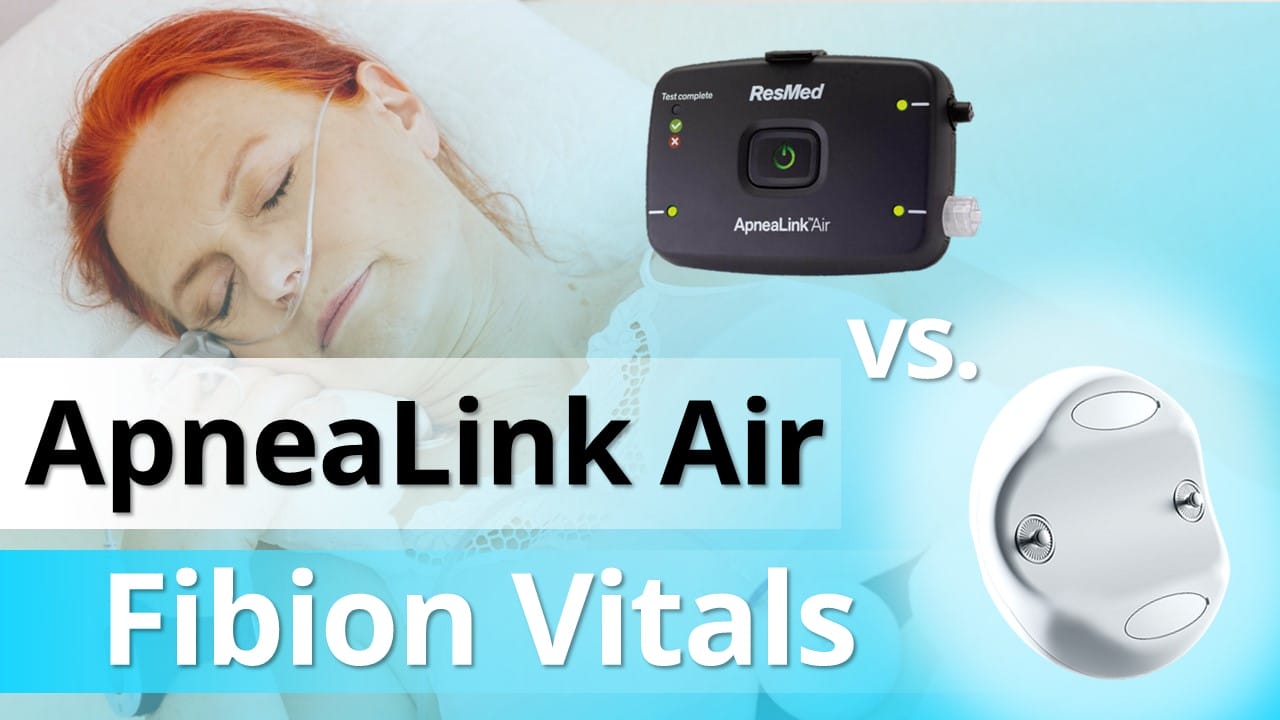1. Introduction
This article looks at Fibion Vitals and ApneaLink Air, two devices used for monitoring sleep. Both are designed to help in research and clinical settings, but they have different features. Fibion Vitals offers a wide range of physiological measurements, including motion, heart rate variability (HRV), and temperature.
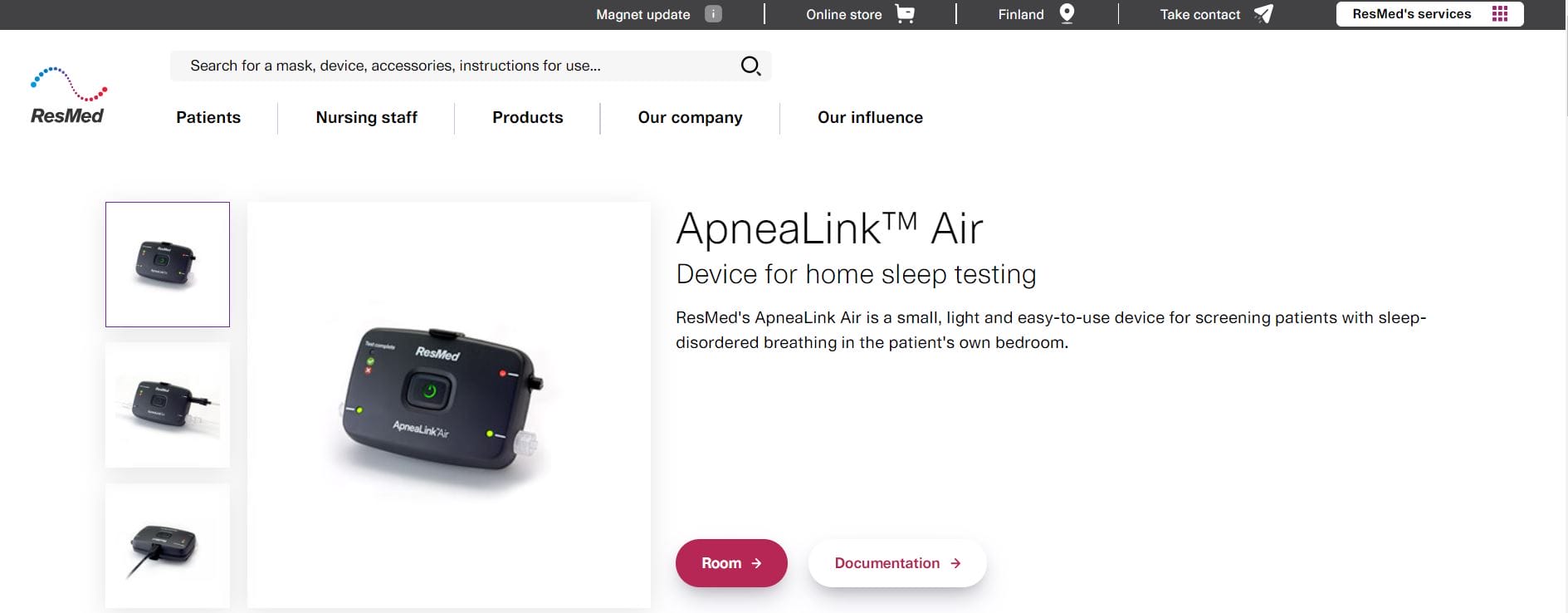
ApneaLink Air focuses on diagnosing obstructive sleep apnea by measuring respiratory functions and oxygen saturation. Fibion Vitals provides several additional biosignals compared to ApneaLink Air comprehensive and detailed sleep measurements. This articles introduces the signals that Fibion Vitals can measure, its applications and its advantages as well as limitations.
2. Enhanced Monitoring Capabilities of Fibion Vitals
Fibion Vitals distinguishes itself by offering an extensive array of physiological measurements, crucial for a deeper understanding of sleep and its disorders. It stands out, particularly for its ability to capture sleep positions, which are vital in assessing sleep-disordered breathing issues.
The device’s 9D motion tracking not only captures detailed movement data but is sophisticated enough to detect when a person is sleeping on their back, side, or stomach. This positional data is key for linking certain sleep positions with breathing problems, providing invaluable insights for sleep research.
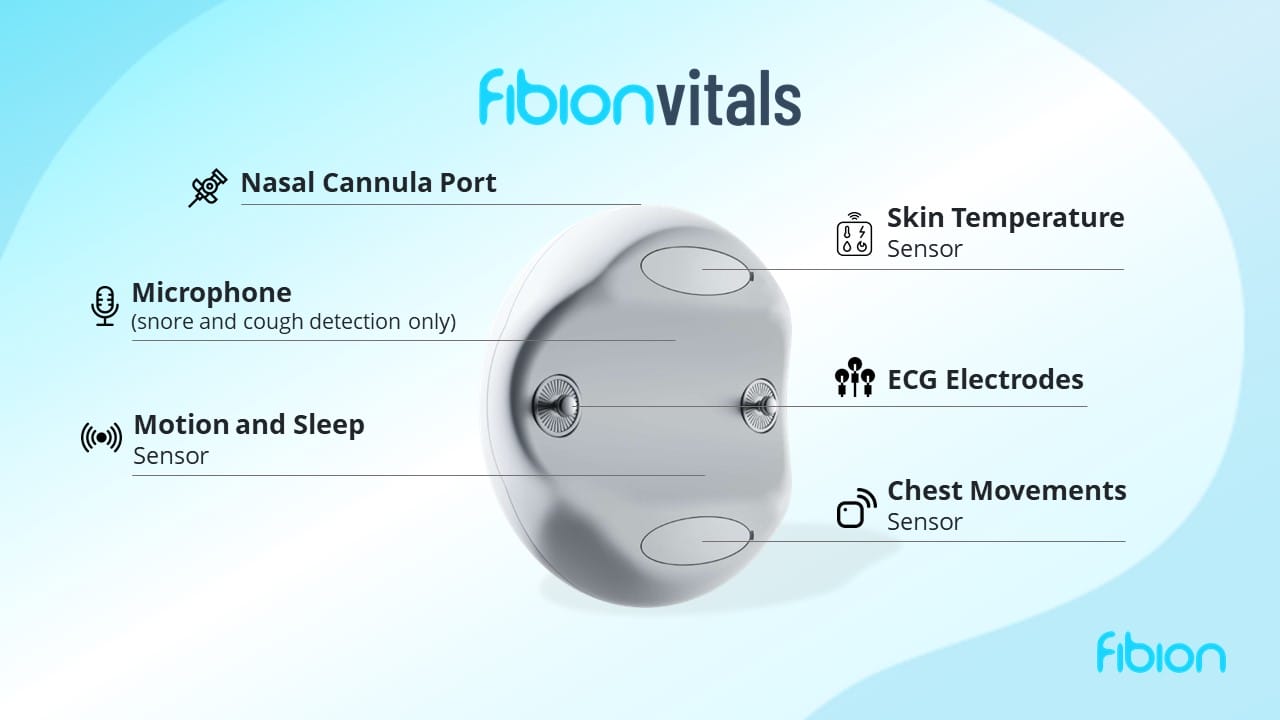
Fibion Vitals also includes pulse oximetry from finger tip. This measures blood oxygen levels, a critical parameter for diagnosing conditions like sleep apnea where oxygen saturation drops during apnea events. Combined with nasal airflow measurement via a nasal cannula and respiration measurements with chest impedance, Fibion Vitals offers a robust toolset for identifying and analyzing sleep apnea episodes and other respiratory issues during sleep. Fibion Vitals has also microphone which is recording sound pressure that can be used to detect both coughing and snoring.
These features show Fibion Vitals’ capabilities in delivering a multi-dimensional view of the subject’s physiological state during sleep. It enables researchers to explore the complex interplay between sleep positions, breathing patterns, and overall sleep quality, making it a versatile and indispensable tool for comprehensive sleep studies.
“Fibion Vitals, with cough and snoring detection, pulse oximetry, respiration and nasal airflow measurement, becomes a powerful ally in sleep apnea research, offering a multi-dimensional view of sleep health.”
3. Fibion Vitals in Research Applications

Fibion Vitals, with its advanced sensor technology, serves a critical role in both research and clinical settings. It collects a wide range of physiological data, including bioimpedance, accelerometer readings, differential pressure sensor data, skin surface temperature, and ECG signals. This diversity in data collection enables comprehensive monitoring of patient health, making Fibion Vitals a valuable tool for various applications.
Research Applications: Researchers can leverage Fibion Vitals for in-depth studies on sleep-disordered breathing, heart rhythm disturbances, and their correlations with different sleep positions. Its capability to detect declines in airflow through the nasal cannula and monitor blood oxygen saturation levels with a pulse oximeter supports detailed analyses of sleep apnea and its management. Additionally, the device’s motion tracking helps in understanding the impact of patient movement and position on sleep quality and respiratory patterns.

In summary, Fibion Vitals stands out for its versatility and depth of data collection, making it an indispensable asset in advancing medical research and improving patient outcomes.
4. Advantages and Limitations
Fibion Vitals, with its comprehensive capabilities for sleep and physiological monitoring, provides significant advantages in both research and clinical settings. It supports a wide range of applications, from detailed sleep studies to the monitoring of chronic conditions. However, like any advanced medical device, it comes with its set of limitations that are important for users to consider.
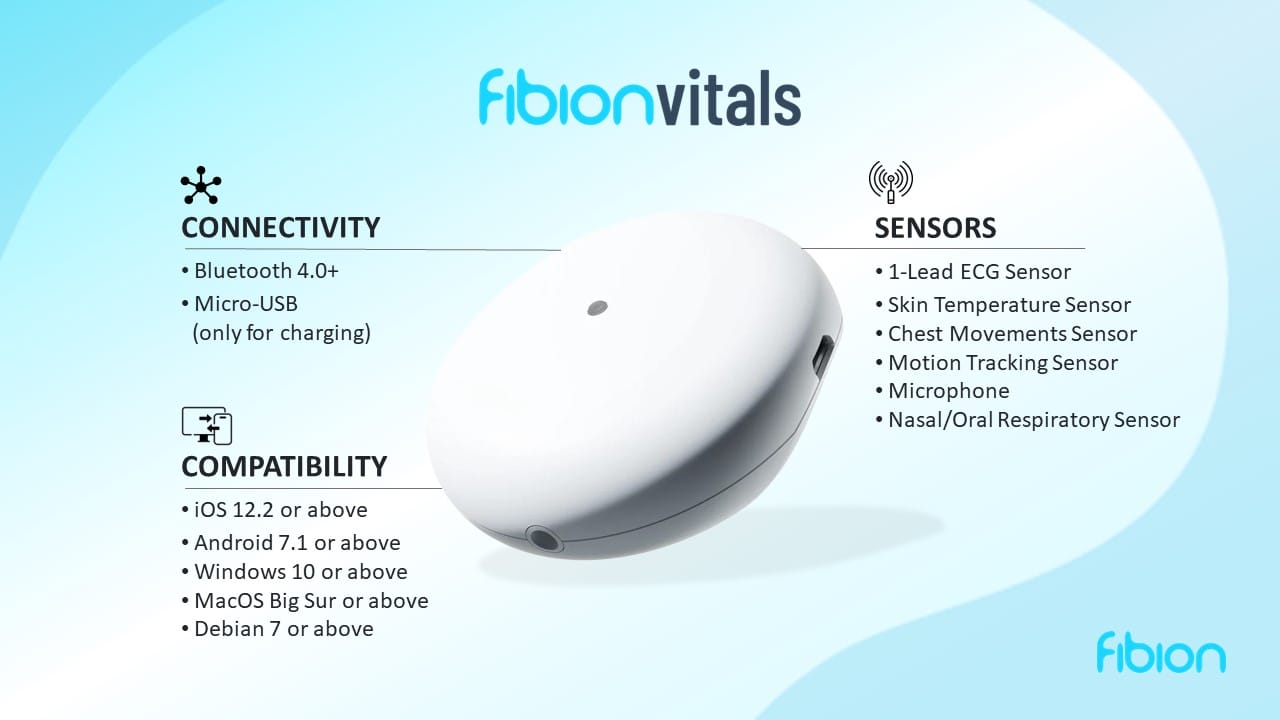
4.1. Advantages
- Multi-Dimensional Monitoring: Fibion Vitals captures a broad spectrum of data including motion, heart rate variability, respiratory patterns, and oxygen saturation. This makes it highly valuable for in-depth analysis of sleep quality and related physiological factors.
- Position Detection for Sleep-Disordered Breathing: The device’s motion tracking accurately identifies sleep positions, crucial for studying sleep-disordered breathing. Understanding the impact of different sleeping positions on breathing can aid in developing more effective treatment plans.
- Real-Time Data Analysis: With its intuitive app, Fibion Vitals provides real-time analysis and feedback, enhancing the user experience for both researchers and participants. This immediate insight into data helps in quicker decision-making and adjustments in study protocols or treatment plans.
- Versatility for Research and Clinical Use: Its wide array of sensors and data collection capabilities make Fibion Vitals adaptable for various research studies and clinical monitoring, offering a single device solution for multiple needs.
“Fibion Vitals stands out in sleep and physiological research, but mastering its advanced features demands patience and creativity.”
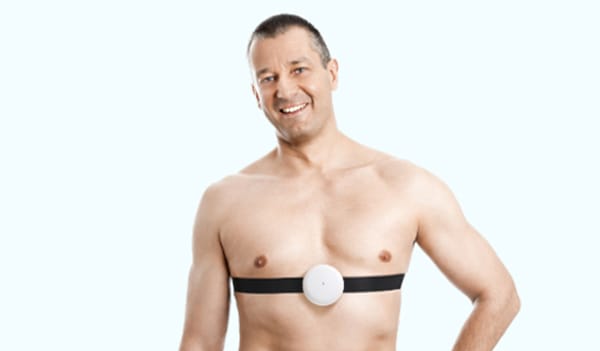
4.2. Limitations
- Learning Curve and Setup: Implementing Fibion Vitals in research or clinical practice may require initial training for users to fully leverage its capabilities. Setting up the device to ensure accurate data collection might also take time.
- Device Management for Large Studies: For extensive studies involving many participants, managing multiple devices and ensuring consistent data collection can be challenging. This may require additional resources for device maintenance and data management.
- Cost Considerations: The advanced technology and capabilities of Fibion Vitals may come at a higher cost compared to simpler monitoring devices. Budget constraints in research grants or clinical settings could limit the accessibility of this device for some users.
In conclusion, while Fibion Vitals offers comprehensive monitoring capabilities and versatility for sleep and physiological research, it is important for potential users to consider the practical aspects of implementing such a comprehensive device in their studies or clinical practice.
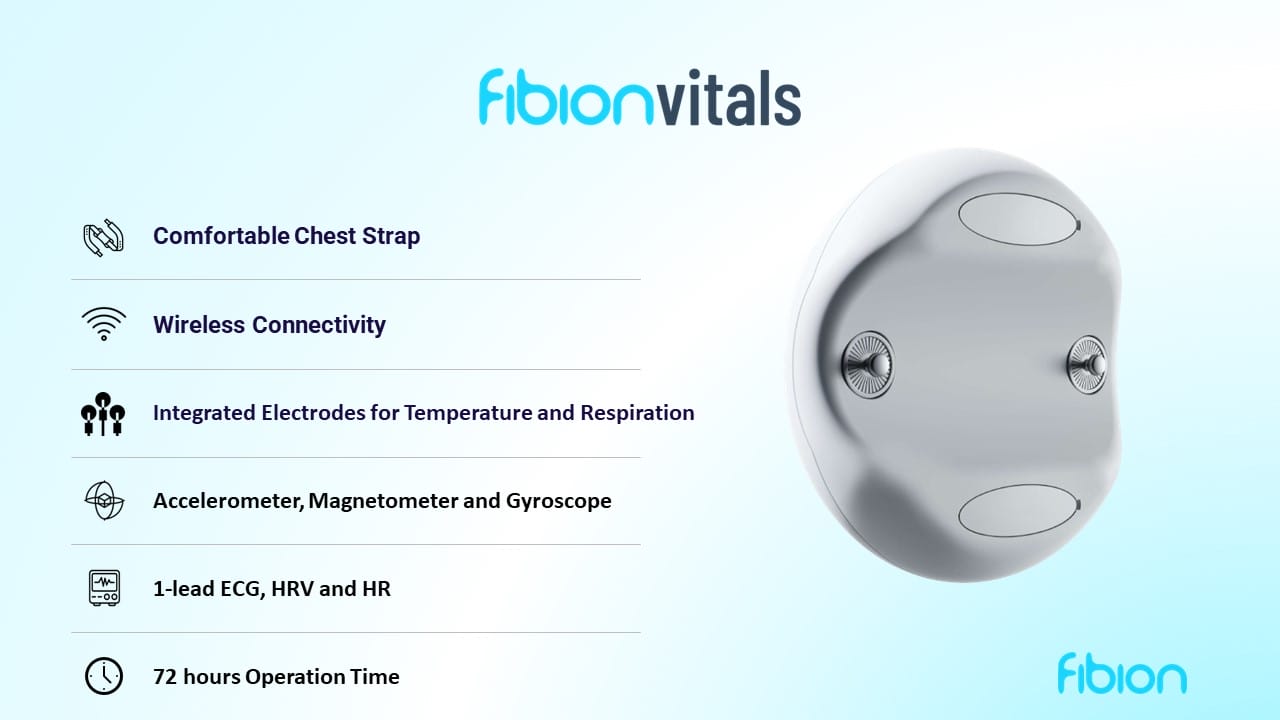
5. Conclusion
Fibion Vitals’ adaptability to various research needs, coupled with its user-friendly interface and secure data management, makes it an invaluable tool for researchers and healthcare professionals. Its ability to provide real-time insights into a patient’s sleep and physiological parameters offers a holistic view of health, paving the way for personalized treatment strategies.
“Fibion Vitals lifts sleep disorder monitoring with its comprehensive data approach, providing insights for customized treatments.”
For researchers and clinicians aiming to push the boundaries of sleep science and patient care, Fibion Vitals presents a great solution for home based measurements, equipped to meet the evolving demands of modern medical research.
Call to action
🚀📊 Learn more about Fibion Vitals
📅 If you are interested to learn more about Fibion Vitals, do not hesitate to book a video call with our expert Dr. Olli Tikkanen.
📚 Explore Our Article Collection in our extensive Sleep collection
Frequently Asked Questions:
What distinguishes Fibion Vitals from ApneaLink Air in sleep monitoring? +
Fibion Vitals offers a broader range of physiological measurements including motion, HRV, and temperature, while ApneaLink Air focuses on respiratory functions and oxygen saturation for diagnosing obstructive sleep apnea.
How does Fibion Vitals enhance sleep-disordered breathing research? +
By capturing sleep positions and offering advanced motion tracking, Fibion Vitals provides crucial insights into the link between sleep positions and breathing problems, aiding in-depth sleep research.
What advanced features does Fibion Vitals offer? +
Fibion Vitals includes pulse oximetry, 9D motion tracking, bioimpedance, accelerometer readings, and ECG signals for comprehensive monitoring of sleep and physiological parameters.
Can Fibion Vitals be used in clinical settings? +
Yes, its advanced sensor technology and comprehensive data collection make Fibion Vitals a valuable tool for diagnosing and managing respiratory and heart rhythm disorders in clinical environments.
What are the limitations of using Fibion Vitals? +
Potential users should consider the learning curve, the need for initial training, device management in large studies, and cost considerations when implementing Fibion Vitals.
Why choose Fibion Vitals over ApneaLink Air for comprehensive sleep studies? +
Fibion Vitals’ extensive physiological measurements and advanced features like sleep position detection and integrated pulse oximetry offer a more comprehensive tool for in-depth sleep research and clinical diagnostics.
Disclaimer:
This comparison of Fibion Vitals and ApneaLink Air is provided for informational purposes only and should not be seen as an endorsement of either product. We do not guarantee the accuracy or completeness of the information. Users are advised to independently verify the information and make decisions at their own risk. We will not be liable for any losses or damages resulting from the use of this information.

